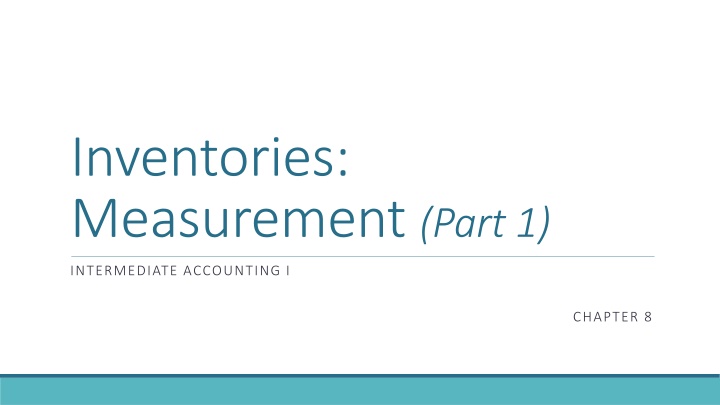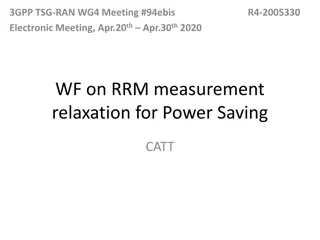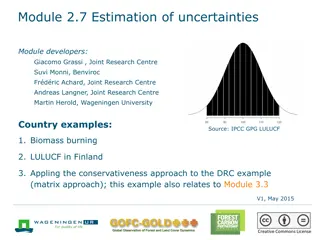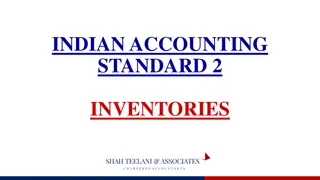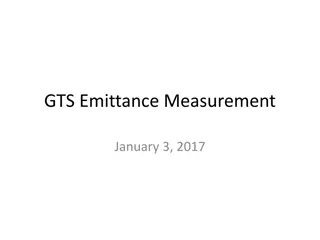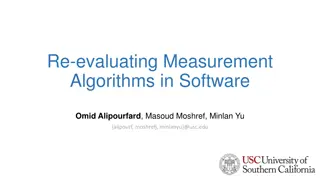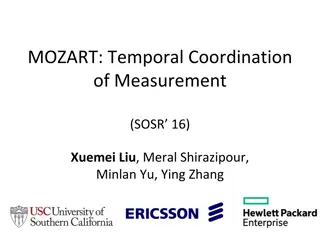Inventories Measurement Overview
In the world of accounting, inventories are crucial assets that comprise physical goods intended for sale, in production, or used in the manufacturing process. This overview covers types of inventory systems, included expenditures, and physical quantities in inventory. Understanding these concepts is essential for accurate financial reporting and inventory management.
Uploaded on Feb 22, 2025 | 2 Views
Download Presentation

Please find below an Image/Link to download the presentation.
The content on the website is provided AS IS for your information and personal use only. It may not be sold, licensed, or shared on other websites without obtaining consent from the author.If you encounter any issues during the download, it is possible that the publisher has removed the file from their server.
You are allowed to download the files provided on this website for personal or commercial use, subject to the condition that they are used lawfully. All files are the property of their respective owners.
The content on the website is provided AS IS for your information and personal use only. It may not be sold, licensed, or shared on other websites without obtaining consent from the author.
E N D
Presentation Transcript
Inventories: Measurement (Part 1) INTERMEDIATE ACCOUNTING I CHAPTER 8
INVENTORY INVENTORY Inventory a current asset which may consist of any of the following Physical goods a company intends to sell in the normal course of business Physical goods a company has in production for future sale (work in process) Physical goods a company uses currently in the production of goods to be sold (raw materials) Inventory for a wholesale or retail company consists of goods purchased in finished form for resale. Inventory for a manufacturing company includes raw materials, work in process, and finished goods.
TYPES OF INVENTORY SYSTEMS TYPES OF INVENTORY SYSTEMS Two accounting systems are used to record inventory transactions. Perpetual Perpetual Inventory inventory cost. Updates the inventory account for purchases, sales, purchases returns, and sales returns. Inventory is debited when merchandise is purchased or returned by a customer Inventory is credited when merchandise is sold or returned to a supplier Inventory System System - - continuously records both changes in inventory quantity and Periodic Periodic Inventory Inventory System of each reporting period. Merchandise purchases, purchase returns, purchase discounts, and freight-in are recorded in temporary accounts. Purchases plus freight-in less returns and discounts equals net purchases. The period's cost of goods sold is determined at the end of the period by combining the temporary accounts with the inventory account: System - - adjusts inventory and records cost of goods sold only at the end Beginning inventory + Net purchases - Ending inventory = Cost of goods sold
EXPENDITURES INCLUDED IN INVENTORY EXPENDITURES INCLUDED IN INVENTORY The cost of inventory includes all expenditures necessary to bring inventory to its desired condition and location for sale or use in manufacturing. The purchase price of goods. Freight charges on incoming goods shipped FOB Shipping Point. Insurance costs while the goods shipped FOB shipping point are in transit. The costs of unloading, unpacking, and preparing merchandise for sale. Cost is reduced by purchase returns and purchase discounts.
PHYSICAL QUANTITIES INCLUDED IN INVENTORY PHYSICAL QUANTITIES INCLUDED IN INVENTORY Generally, physical quantities included in inventory consist of items in the possession of the company. Goods in transit If the goods are shipped f.o.b. (free on board) shipping point, then legal title to the goods changes hands at the point of shipment when the seller delivers the goods to the common carrier. If the goods are shipped f.o.b. destination, the seller is responsible for shipping and legal title does not pass until the goods arrive at the customer's location. Goods on consignment Goods on consignment should be included in inventory of the consignor even though not in the company's physical possession. The consignor records a sale only when the consignee sells the goods. Sales Returns A company includes in inventory the cost of merchandise it anticipates will be returned. Exercise 8 8, page 459
PURCHASE DISCOUNTS PURCHASE DISCOUNTS Purchase discounts represent reductions in the amount to be paid if remittance is made within a designated period of time. Purchase discounts may be recorded using Gross Method Discounts are recorded only when taken Discounts reduce Inventory (Perpetual system) or are recorded in Purchase Discounts (Periodic system) Net Method Discounts are recorded at the time of purchase Discounts not taken are recorded as Interest Expense (Perpetual or Periodic system)
PURCHASE DISCOUNTS PURCHASE DISCOUNTS Example 1 Example 1 On July 31, Sun Productions bought 50 widgets for $100 each from a vendor with terms of 2/10, n/30. The company paid for 20 of the widgets on Aug 9 and paid for the remainder on August 31. Prepare the journal entries using the gross method with a perpetual inventory system. Jul 31 Inventory Accounts Payable 5000 5000 Aug 9 Aug 31 Accounts Payable Cash Accounts Payable Cash Inventory 2000 1960 40 3000 3000
PURCHASE DISCOUNTS PURCHASE DISCOUNTS Example 2 Example 2 On July 31, Sun Productions bought 50 widgets for $100 each from a vendor with terms of 2/10, n/30. The company paid for 20 of the widgets on Aug 9 and paid for the remainder on August 31. Prepare the journal entries using the gross method with a periodic inventory system. Jul 31 Inventory Accounts Payable 5000 5000 Aug 9 Aug 31 Accounts Payable Cash Accounts Payable Cash Purchase Discounts 2000 1960 40 3000 3000
PURCHASE DISCOUNTS PURCHASE DISCOUNTS Example 3 Example 3 On July 31, Sun Productions bought 50 widgets for $100 each from a vendor with terms of 2/10, n/30. The company paid for 20 of the widgets on Aug 9 and paid for the remainder on August 31. Prepare the journal entries using the net method with a perpetual inventory system. Jul 31 Purchases Accounts Payable 4,900 4,900 Aug 9 Aug 31 Accounts Payable Interest Expense Cash Accounts Payable Cash 1,960 1,960 2,940 60 3,000
PURCHASE DISCOUNTS PURCHASE DISCOUNTS Example 4 Example 4 On July 31, Sun Productions bought 50 widgets for $100 each from a vendor with terms of 2/10, n/30. The company paid for 20 of the widgets on Aug 9 and paid for the remainder on August 31. Prepare the journal entries using the net method with a periodic inventory system. Jul 31 Purchases Accounts Payable 4,900 4,900 Aug 9 Aug 31 Accounts Payable Interest Expense Cash Accounts Payable Cash 1,960 1,960 2,940 60 3,000
Inventories: INTERMEDIATE ACCOUNTING I CHAPTER 8 Measurement (Part 1) END OF PRESENTATION
